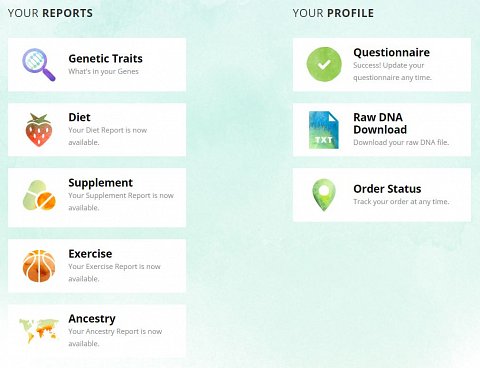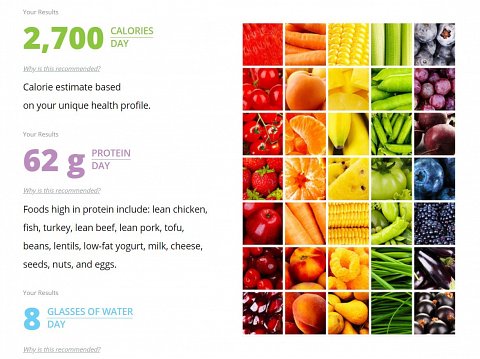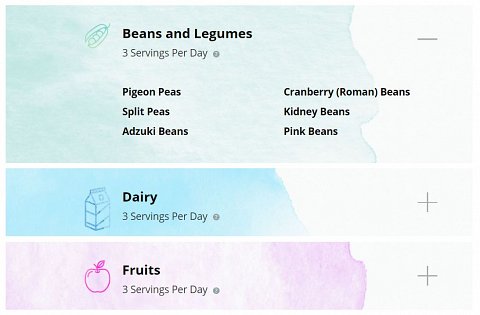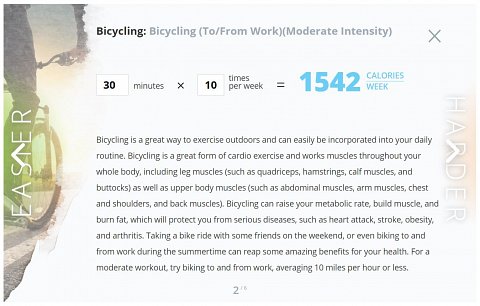-
Health and Ancestry Report
review on January 10, 2019
by Rebecca Fishwick

At a Glance
Summary
The Health and Ancestry Report provided by Vitagene was both engaging and interactive. I enjoyed looking through my recommendations, particularly my fitness planner, which was well-designed and fun to use and explore. I was glad to see that the reports included details of the areas of my genome they had examined to produce my results, which would be useful if I wanted to do further research into my genetics.
The health information was practical and actionable, and I looked forward to trying out my recommendations.
Full Review
Vitagene was founded by C.E.O. and neurosurgeon, Reza Malek. Their team consists of experts in integrative medicine and genomics, as well as computer systems and product design. Based on the principle that we are all genetically diverse, the company aims to provide genetic health tests that are science-driven, affordable, comprehensive, and tailored to the individual.
Please note that reviews for the ancestry-related aspects of the test can be found here.
Product Expectations
The test I was to take was the ‘Health and Ancestry Report’, so I went to the Vitagene website to find out more.
The site was bright, clear, and well laid out. Here, I learned that my test kit would arrive three to five days after ordering, and I would take my DNA sample using a cheek swab (no blood!). Once my DNA had arrived at the lab, it would take four to six weeks for them to analyze it, after which I’d get my results.
There was a note about privacy, where I learned that Vitagene would use industry standard security practices to store my DNA sample, test results, and personal data. They wouldn’t sell or publish my information with any third parties.
Looking through the information for the Health and Ancestry Report, I discovered my results would consist of four main categories: diet, fitness, ancestry, and supplement recommendations. I could click on the icons for these categories to view sample sections from the report.
I learned that the diet section would contain a customized food list, and a closer look at how my DNA could affect my eating behaviors and weight management goals. I would also receive a personalized supplement plan.
The fitness report would contain a personalized exercise program, and information about how my body responds to exercise in terms of weight loss, whether I’m predisposed to be better at power training or endurance, and more.
I had a look at the “How It Works” page, which showed the steps of taking the test, and also a picture of what would be included in the kit. Here, I learned that people who already had their genetic data could upload this instead of taking a new test, in which case they’d receive their results in only one to two weeks. I saw that my DNA would be analyzed in a CLIA (Clinical Laboratory Improvement Amendments of 1988) and CAP (College of American Pathologists) approved lab.
Ordering Experience
Ordering the Health and Ancestry Report was pretty straightforward. I could order from the information page or from the online shop, where I could get reports at a discount if I already had my DNA analyzed by 23andMe, AncestryDNA or MyHeritage.
To order, I had to input my full name and email address, and then a phone number, a shipping/billing address, and card details.
I had a look through the Terms of Use, where I discovered that Vitagene’s DNA tests were only intended for people over 18. In the Privacy Policy, I learned that they would only share my information with my physician if I directed them to, that any personal information would only be shared with other parties in order to allow me to use their service (for instance, a credit card processor, or Vitagene’s partner lab, where my DNA would be analyzed).
There was also a Consent to Research form. This was very comprehensive, and I did not have to consent to research in order to take their tests.
The kit arrived promptly, in a neat package that resembled a picture I’d seen on the site. It contained instructions for taking a DNA sample, and a pre-addressed and prepaid box I could use to return my sample to the lab.
I needed to register my kit online using the provided code, which required me to create a password for my online account, select whether I was male or female at birth, and agree to the Terms of Use and Privacy Policy.
Once I’d confirmed my email, I could take a questionnaire about my current state of health and my fitness goals, which would be used to tailor my report.
I was asked what my main goal was in improving my health (this was multiple choice: I chose that I wanted to boost my energy levels), and a series of health-related questions, such as whether I’d ever had any surgeries, and what allergies I had. I could also input my height and weight.
If I followed a specific diet (vegetarian, gluten-free, ketogenic, etc.), then I could select one or several, which would alter my recommendations accordingly. I could also input my current activity levels, and select the fitness activities I enjoyed doing (such as swimming, running, and so on).
Two weeks after the lab received my sample (sooner than I’d expected!), I had an email to say that my results were ready.
The Results
My results email contained a link to my online account, where I could log in using the password I’d already created. Here, I was taken to my dashboard, where I could view my reports for genetic traits, diet, supplements, exercise, and ancestry. I could also update my questionnaire answers, or download my raw DNA data.

My dashboard.
Results Section: My Genetic Traits
Clicking on “Genetic Traits”, I saw I could play a short video that guided me through this section, which included diet traits such as caffeine and alcohol metabolism, and exercise-related traits like muscle strength and weight response.
For each trait, I was given both my genetic predisposition, and some information about it. For example, my alcohol metabolism result showed that I was likely to metabolize alcohol normally. In the information, I learned that genetics only influenced about 50% of the differences in alcohol metabolism between people, and that this rest was up to the environment, meaning that though my genes suggested I could metabolize alcohol normally, environmental impacts may mean I am actually better or worse than average.
Vitagene had provided the name of the “SNP” (Single Nucleotide Polymorphism) they had looked at to get my result. A SNP was described as a change “where genetic code varies by a single letter”, which could affect how I react or benefit from exposure to different things, such as alcohol.
I was pleased to see that my genetic results had been provided, since this meant I could look up my genotypes if I wished. There was also a “Research Citations” section for each result, showing the research papers they had referenced.
Among my exercise traits, I found that I was likely to perform well with a mixture of endurance and power activities, and that I was less likely to experience muscle cramps, and more likely to lose weight through exercise. Having read through them, I was interested to see how my traits results would affect my diet and fitness recommendations.
Results Section: Diet Recommendations
Next, I took a look at my diet recommendations. I found I had a healthy BMI, falling into the “normal” range (18.5–24.9). In the information video, I learned that the BMI score was useful for most people, but might be misleading for those with a very high muscle mass.
The results were laid out in a way that was clear, simple, and colorful. My basic guidelines were to consume around 2,700 calories a day, eat 62g of protein, and drink eight glasses of water (shown below).

My diet guidelines.
Scrolling down, I found I had been recommended a diet that was high in zinc, magnesium, monounsaturated fats, fiber, and polyunsaturated fats. I could click on each of these to see why I had been recommended them. From the information, I learned that high zinc and magnesium consumption would improve my energy levels, while mono- and poly-unsaturated fats and fiber would improve my heart health. These recommendations had been generated using both my questionnaire answers and my genetic analysis.
I had also been given a diet plan, which was well-presented and expandable (shown below).

My diet plan.
I could expand or contract each food type to show examples of the foods it included. Hovering the mouse over the little question mark beside the serving suggestion gave examples of what a typical serving might be. For example, one serving of beans or legumes might be half a cup of cooked beans and lentils. For the truly dedicated, this diet plan could be used to help create a full meal plan, though I imagined it would still make a good guideline for anyone less organized or industrious!
Results Section: Supplement Plan
From the diet plan, I could have a look at my supplement plan. Like my diet plan, this was expandable, colorful, and easy on the eye.
According to the information video, the supplement plan had been tailored for me using both the questionnaire, and my genetic analysis. As I altered my health and fitness goals, or other questionnaire information (such as my weight or energy levels), the supplement guide would change with me.
I could order supplements from Vitagene, or use the plan to help me choose supplements for myself.
As well as the “VitaPlan”, the supplements section also had “Overview” and “Quality” tabs. In the Overview, I read that due to modern agricultural techniques, today’s soil is deficient in important vitamins and minerals, which affects the food we eat. Apparently, this meant that we have to eat eight oranges to get the same amount of vitamin A that was in one orange 50 years ago.
Clicking the “Quality” tab, I found more information about Vitagene’s own supplements. I read that over 90% of most supplements were comprised of “scary fillers”, though what was so scary about these fillers I wasn’t sure. I found that Vitagene’s vitamins were gluten free, with no artificial colors, flavors, or chemical preservatives.
Results Section: Exercise Recommendations
Clicking on “Exercise”, I found I could select my favorite ways to work out. Selecting different activities (running, yoga, cycling, etc.) altered my weekly calorie burn estimate, and told me how many pounds I was likely to lose in a month.
I could also alter how many minutes I did or intended to do each activity for, how many times a week, and at what intensity. This would alter the amount of calories burned per week (shown below).

My bicycling workout and calorie burn estimate.
As you can see, for each form of exercise I was given information about which parts of the body were used or affected, and how this could benefit my health. For instance, I found that bicycling could help raise my metabolic rate, build muscle, and burn fat, while yoga could reduce my heart rate and blood pressure, and help regulate blood glucose levels.
This section in particular I found wonderfully laid out, interactive, and informative. It seemed to have little relation to my genetic results, but still I supposed I could use the information in my fitness traits section to help me decide which forms of exercise to do. Though, like most people, I’d probably be more guided by my own preferences.
Summary
The Health and Ancestry Report provided by Vitagene was both engaging and interactive. I enjoyed looking through my recommendations, particularly my fitness planner, which was well-designed and fun to use and explore. I was glad to see that the reports included details of the areas of my genome they had examined to produce my results, which would be useful if I wanted to do further research into my genetics.
The health information was practical and actionable, and I looked forward to trying out my recommendations.
Please note we were invited to take this test free of charge.


